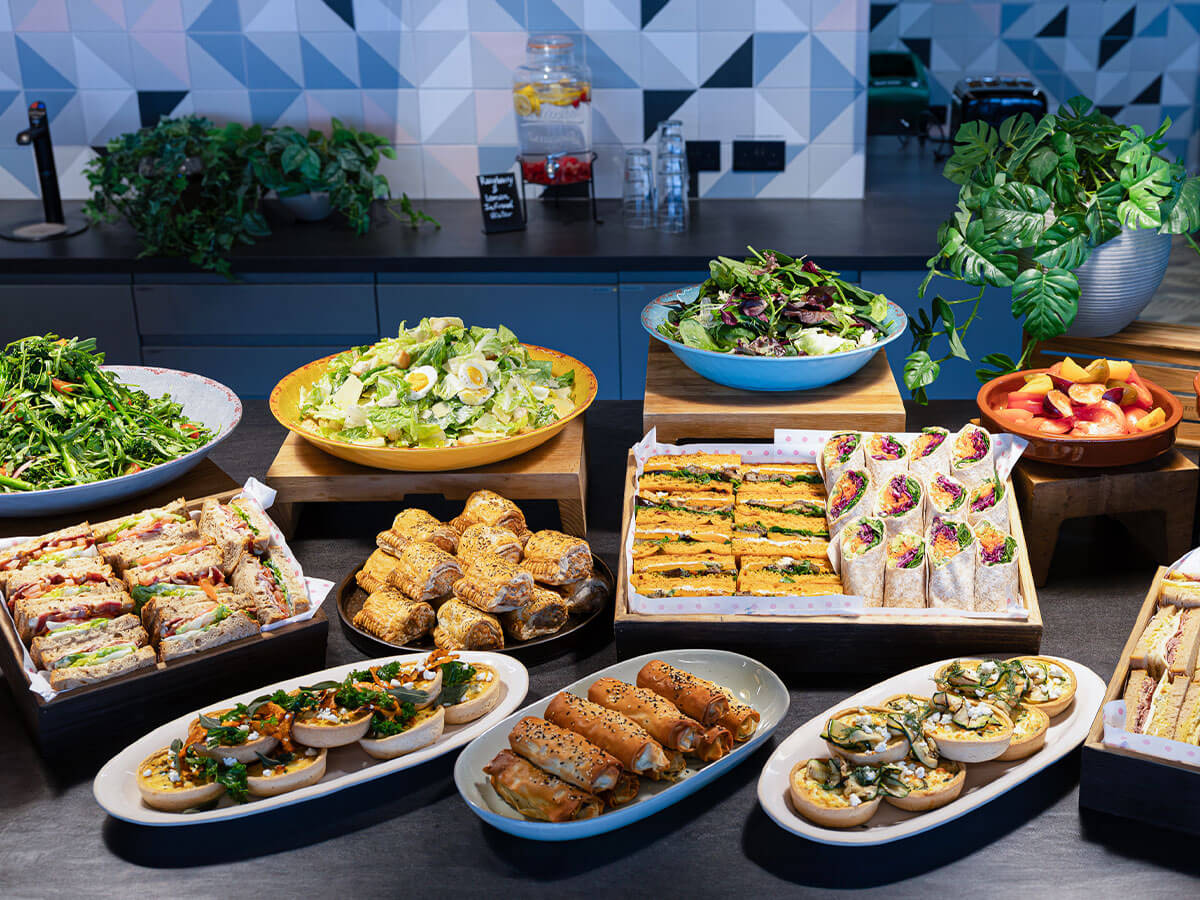Without a happy workplace, few companies reach their full potential. But what does ‘happy’ in the office look like? The best office catering companies will tell you that good food has a big role in shaping workplace culture, significantly impacting recruitment, retention, and overall employee satisfaction levels.
To many facilities, office and workplace experience managers in the capital, getting to grips with food programmes can feel overwhelming. Their current catering model might be causing them unnecessary stress. But determining the precise aspects causing frustration and understanding the full range of potential alternatives may feel too big a task for already-busy schedules.
So in this article, we’ll first examine three different catering models – traditional catering, aggregator foodservice, and contract catering services, better known as delivered-in catering – and then compare them across ten key criteria. We’ll weigh the pros and cons of each and offer tips on what to look for when making this important business decision.
What is traditional office catering?
This model, typically used for workplace catering lunch programmes, revolves around an on-site kitchen, in-house staff (provided by a third party), and long-term catering contracts. While all food is prepared on-site, problems can arise due to catering managers facing mountains of paperwork and operations managers juggling too many offices at once. The result is a catering contract that risks tying the client to a subpar service.
Traditional catering requires several significant elements to work well: a high degree of involvement from the workplace experience manager, a sizeable space (and extraction unit) for the kitchen, high capital investment to fund the kitchen fit, and high labour costs for kitchen staff. However, subsidised rather than free meals offer businesses a way to regain some of their costs.
What is an aggregator foodservice?
Aggregator foodservice – direct restaurant ordering on demand – is easy to understand because it’s so widely used by millions of people. Think of Deliveroo as the ultimate aggregator foodservice. Simply pick a restaurant and meal, then have it delivered to your chosen address. Et voila!
Whilst aggregator foodservice is a great entry to providing employees with complimentary meals, issues arise when the headcount exceeds 20 to 30 employees. When teams grow, this type of service can become overwhelming and chaotic for office and facilities managers, including order mix-ups and cleaning up after mealtimes.
For offices, aggregator food services may provide an account manager who can offer some tailored advice. However, that personal service is unlikely to match the service of delivered-in or traditional catering models.
What is delivered-in catering?
Delivered-in catering services offer expertise, variety, innovation and flexibility – all from an off-site restaurant-style kitchen. With everything centralised in one place, operations become more straightforward. This means the quality of food and service increases exponentially, allowing for a smooth office lunch delivery.
Think of a cross between a restaurant and a traditional catering kitchen: every day, trained chefs use local ingredients to prepare delicious dishes before they’re delivered to offices nearby. This is the model Fooditude operates for office catering in London.

Office Catering London: 10 Criteria to Compare Different Catering Models
1. Quality
Traditional:
Varies depending on budget, from cafeteria-style through to silver service. Expect to pay roughly £10 to £15 per head per day to cover the costs of ingredients, labour, and management and still get good quality food.
Aggregator foodservice:
Things can go wrong quickly, especially with larger headcounts. Is the restaurant good? Is the driver fast and reliable? Food can arrive cold or mislabelled (crucial for people with allergies). Incorrect orders can also occur.
Delivered-in:
Food quality is always good by using fresh ingredients and cooking from scratch each day. Full control over staff means service is also excellent. Look for providers (like Fooditude) with SALSA accreditation and 5-star ratings from local environmental health officers.
2. Flexibility
Traditional:
Overstretched operations and catering managers have little time for innovation. In-house kitchens may also find it difficult to cater for fluctuating headcounts created by hybrid working.
Aggregator foodservice:
Limited by each restaurant’s menus. While the option is there to order from multiple restaurants, this can be a logistical nightmare for larger teams with different dietary needs.
Delivered-in:
Headcounts can be adjusted weekly, enabling the service to scale up or down at short notice. Quieter days can be catered with simple snacks rather than a full lunch service. With supervisors not burdened by paperwork, delivered-in services also have the time and space needed to innovate with menus.
3. Dietary and allergen needs
Traditional:
With the kitchen and ingredients on-site, traditional catering services can easily handle most dietary needs, depending on the size and scale of their facilities. There’s even the capacity to cook last-minute requests.
Aggregator foodservice:
Unlabelled allergens can pose more of a risk with aggregator foodservice. Cross-contamination could occur, and labelling is not always clear or accurate. Large group orders with individual dietary needs also become difficult to process.
Delivered-in:
In diverse cities like London, delivered-in services cater to different diets, cultures, preferences and lifestyles. At Fooditude, we list all 14 allergens when producing any menu. We even provide online interactive menus, in which users can filter out dishes according to allergies or dietary requirements.
4. Food prep and storage
Traditional:
Food is prepared on-site and then served in the canteen. High energy costs mean it is increasingly expensive to keep food hot or cold as required.
Aggregator foodservice:
Less guarantees over the quality or method of food prep, as multiple kitchens from different companies are used. This system relies on less centralised delivery operations than delivered-in catering, which can impact the quality of the food, making it potentially cold or lukewarm on arrival.
Delivered-in:
Has control over every part of the operation, so each step of the journey is normally meticulously executed. Hot and cold food is stored and delivered in state-of-the-art containers, ready for the on-site front-of-house team to serve on heated or chilled plates. Reusable storage containers also minimise waste.
5. Menu diversity
Traditional:
Initially offer diversity in their menus. But due to the limitations of a smaller on-site kitchen, menus risk becoming cyclical over time – including ‘Specials of the Day’. Some contracts provide ‘standard’ menus. These tend not to change regularly, leaving employees bored by the same food options.
Aggregator foodservice:
No single restaurant is likely to be able to meet the needs and preferences of a large team. Ordering from multiple restaurants – and dealing with the complications that come with that – is an inevitable reality.
Delivered-in:
At Fooditude, we offer seasonal menus. These change daily over a period of four weeks, giving diners the option to try many vibrant recipes in any given month. In short, a larger and better equipped central production kitchen means the scope of what can be cooked is greater.
6. Delivery
Traditional:
Not needed, so no risk of late or disappointing deliveries.
Aggregator foodservice:
Suitable for one-off team meetings or projects, but reliance on third-party deliverers is not sustainable for daily food provisions when accurate timings and correct orders are key. If something goes wrong, you’ll rarely have the time to send it back or request a new order.
Delivered-in:
In-house drivers and delivery vans eliminate the risk of third-party services. The same drivers and on-site teams work with each business every day, providing a familiar, friendly and personalised service.
7. Contracts
Traditional:
Significant investments from both sides (labour, kitchen, equipment) results in long-term, fixed and often inflexible agreements.
Aggregator foodservice:
No contracts and complete day-by-day freedom – but keeping track of all the one-off receipts can quickly become an admin nightmare.
Delivered-in:
No long, inflexible deals. Meals orders can be scaled up or down each week depending on your headcount.
8. Vendor relationships
Traditional:
Workplace experience managers have direct relationships with catering and operations managers. However, the heavy workloads of catering and operations managers can put strain on their relationships with individual clients.
Aggregator foodservice:
Account management services are offered for frequent large-scale orders. But it’s very difficult to scale and work closely to develop a food programme.
Delivered-in:
Personalised on every level. Operations managers have fewer clients to manage than in traditional catering, giving them more time to dedicate to your needs. This improves service and ideation levels. Consistency in drivers and front-of-house staff also enables relationships to develop and ensure hires align to your company culture.
9. Operations
Traditional:
With so many clients to oversee, operations managers can be hard to pin down. Normally only day-to-day catering managers are on-site.
Aggregator foodservice:
No direct operational involvement. Workplace experience managers have no say in the service provided.
Delivered-in:
Fooditude’s model involves an off-site hub that handles everything. Operations managers visit each client weekly. Monthly catch-up meetings and quarterly reviews also take place. Meanwhile, catering managers have less paperwork to do, giving them space to produce fresh menu ideas. Drivers and front-of-house staff have perfected their roles, working to one centralised system.
10. Costs
Traditional:
High overheads (equipment, staff) and questionable use of valuable real estate (kitchen).
Aggregator foodservice:
Not designed for large offices, with price-per-head costs quickly spiralling. Even with high-volume budget options, companies must still factor in extra costs. No service is provided and immersive dining is difficult to pull off.
Delivered-in:
Less fixed than traditional catering; more fixed than aggregator food services. Menus can be scaled up or down depending on budget and staff requirements. Centralised operations eliminate the need for an on-site kitchen team.

Moving forward with office catering in London
If you’re hunting for the best office catering in London, there’s plenty to consider. But faced with the challenges and costs of both traditional and aggregator food services, innovative companies are increasingly turning to Fooditude’s delivered-in service. Here’s why:
- The ability to scale up or down on a weekly basis allows companies to navigate hybrid working structures where the number of in-office staff may fluctuate.
- Consistent on-site staff enables companies to build key relationships with drivers, servers, and operations managers.
- One company overseeing every aspect of the production and delivery process guarantees high quality, good value food delivered on time and in perfect condition.
- By cooking from scratch with only the freshest ingredients, refreshing menus for every season, and understanding all aspects of allergens and dietary preferences, Fooditude ensures your team engages with your food programme and values its contribution to creating a happy and vibrant workplace.
To find out more about how our delivered-in catering service is the best option if you’re looking for modern, high-quality office catering in London, contact us today.




